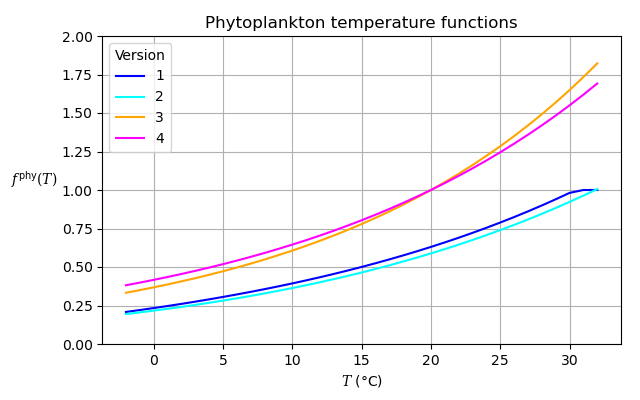\(\newcommand{\p}[1]{\frac{\partial }{\partial #1}}\) \(\newcommand{\pp}[2]{\frac{\partial #1}{\partial #2}}\) \(\newcommand{\dd}[2]{\frac{d #1}{d #2}}\) \(\newcommand{\h}{\frac{1}{2}}\) \(\newcommand{\op}[1]{\operatorname{#1}}\)
8.7.3.19. Temperature dependence¶
Temperature functions are selected by the cpp options DARWIN_TEMP_VERSION and DARWIN_TEMP_RANGE. The cpp option DARWIN_NOTEMP turns off all temperature dependence. The temperature dependence of mortality and grazing can be turned off for individual plankton types by setting the traits tempMort, tempMort2 and tempGraz to 0.
Note that the temperature functions in all versions except 1 can be greater than 1.0.
8.7.3.19.1. DARWIN_TEMP_VERSION 1¶
where the exponential is only present with DARWIN_TEMP_RANGE.
8.7.3.19.2. DARWIN_TEMP_VERSION 2¶
where the second exponential in \(f^{{{\text{phy}}}}\) again is only present with DARWIN_TEMP_RANGE.
8.7.3.19.3. DARWIN_TEMP_VERSION 3¶
where \(A_{{\mathrm{e}}}=0.05/{}^\circ{\rm C}\) 1 and \(T_{\text{ref}}=20\,^\circ{\rm C}\).
8.7.3.19.4. DARWIN_TEMP_VERSION 4¶
Temperature functions are exponential, with an optional restriction on their range,
where \(T_{\text{ref}}=20\,^\circ{\rm C}\) and the exponentials with \(e^{*}_{2j}\) are only present if DARWIN_TEMP_RANGE is defined. The main exponential temperature dependence corresponds to the use of a Q10 temperature coefficient,
where
The default value corresponds to \(Q_{10}\approx1.55\).
Note that while the temperature dependences of versions 2, 3 and 4 are similar, versions 3 and 4 yield rates about 70% higher than version 2 with the default TempCoeffArr. The magnitude of version 1 functions is similar to version 2 ones. Default phytoplankton temperature functions for all DARWIN_TEMP_VERSION. shows the phytoplankton temperature functions with default parameters for the four versions.

Figure 8.16 Default phytoplankton temperature functions for all DARWIN_TEMP_VERSION.¶
The parameters of all temperature functions are summarized in Table 8.57.
Trait |
Parameter |
Default Value |
|---|---|---|
for version 1: |
||
\(c_j=1/3\) |
||
\(e_{1j}=1.04\) 2 |
||
\(n=0.3\) |
||
for version 2: |
||
\(c^{\text{Arr}}=0.5882\) |
||
\(A^{\text{Arr}}_{{\text{e}}}=-4000\,{\rm K}\) 3 |
||
\(T^{\text{Arr}}_{\text{ref}}=293.15\,{\rm K}\) |
||
for version 4: |
||
\(A^{\text{phy}}_{\text{e}j}=0.0438/{}^\circ\mathrm{C}\) 4 |
||
\(A^{\text{het}}_{\text{e}j}=0.0438/{}^\circ\mathrm{C}\) |
||
\(A^{\text{graz}}_{\text{e}j}=0.0438/{}^\circ\mathrm{C}\) |
||
\(A^{\text{remin}}_{\text{e}}=0.0438/{}^\circ\mathrm{C}\) |
||
\(A^{\text{mort}}_{\text{e}}=0.0438/{}^\circ\mathrm{C}\) |
||
\(A^{\text{mort2}}_{\text{e}}=0.0438/{}^\circ\mathrm{C}\) |
||
\(A^{\text{uptake}}_{\text{e}}=0.0/{}^\circ\mathrm{C}\) |
||
for TEMP_RANGE: |
||
\(e_{2j}=0.001\) |
||
\(T^{\text{opt}}_j=2.0\,^\circ{\rm C}\) |
||
\(p_{j}=4.0\) |
||
\(e^{\text{het}}_{2j}=0.001\) |
||
\(T^{\text{opt het}}_j=2.0\,^\circ{\rm C}\) |
||
\(p^{\text{het}}_{j}=4.0\) |
||
\(e^{\text{graz}}_{2j}=0.001\) |
||
\(T^{\text{opt graz}}_j=2.0\,^\circ{\rm C}\) |
||
\(p^{\text{graz}}_{j}=4.0\) |
With random trait generation, \(T^{\text{opt}}_j\) is drawn from a range [tempmax–temprange, tempmax].